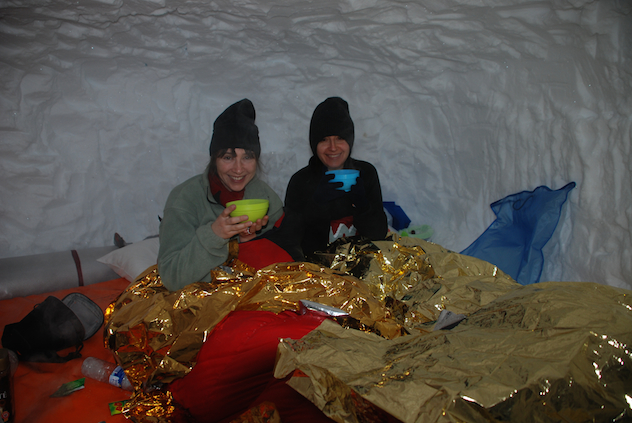Ultimate Guide to Hut-to-Hut Snowshoeing: Essential Kit List and Tips for Your Winter Adventure
There’s something special about moving quietly through the Alps on snowshoes: the gentle crunch of
Read MorePosted 06-02-2012 by Sally Guillaume
Snow has been used by the Inuit for its insulating properties for centuries and they are the masters of igloo building - constructing all types of snow shelters from overnight hunting shelters to full igloo villages. So how long does it take to build an igloo, how do you make an igloo and really how warm is it in an igloo? You can find out for yourself on any of our winter activity holidays or stay at home and read about it here!
For a beginner, it can take 3 - 6 hours to build a sleepable in Inuit style igloo but the conditions need to be right. To build an igloo (which is made with blocks) you need hard packed snow that you can cut and shape to be able to cut out the blocks.
There is also a skill required for the actual construction and it can take a few attempts to get it right. A snow shelter or quinzee is a good alternative. It requires much less skill to build and is as warm as an igloo.
You still need to have enough and the right kind of snow to build one though. The ideal snow for building a snow shelter is the sort of snow that makes good snowballs. Very powdery and sugar like snow is impossible to build a snow shelter with. In these situations you need to dig down to harder packed snow or find wind swept packed snow in a drift. The snow crystals in wind packed snow interlock so it sticks together better making it possible to build with!

Find a good spot for your shelter. It's vital to choose a safe location away from avalanche prone slopes or cornices. It will also make your life a lot easier if you choose areas where there is a natural accummulation of the right kind of snow - snow drift!!!
Mark a circle in the snow. For 2 people you will need a circle of around 2 metres diameter and for 4 people around 4 metres.
Shovel a pile of snow into a large reasonably steep mound. If you can keep the sloping sides at an angle of around 35 degrees or higher that is best for stability. Wide, short snow shelters are more prone to collapse. Mix snow of different temperatures to help it to harden, or “sinter.”
In deep snow begin by digging a trench downward into the snow towards your mound. This should be on the downhill side and out of the wind if possible. As you dig place the snow that is being removed from the trench on top of your mound. In these conditions make the trench as deep as you are tall.
Leave the snow to settle or 'sinter' for about 90 minutes if possible.
Begin tunneling in. At a point at about knee level in your trench make the entrance. Make the tunnel slightly wider than your body and tunnel at a slightly upwards angle. Ideally the floor of the snow shelter should be at least 30cm above the entrance, this will help prevent warm air from escaping the shelter. After the initial entrance is made it is easier to hollow from the top down. The walls should be 30 - 60cm thick. You can poke sticks through the walls to mark and measure the thickness. Leave an elevated platform for sleeping on. As heat rises you are in the warmest part of the igloo for sleeping!
Make an air vent in the wall of the shelter. This is very important - to stop you suffocating in the night!
Block the entrance with a block of snow or rucksack.
Smooth the inside walls - this will help control dripping!
Building a snow shelter will make you sweat. Strip into underlayers and shells if possible to build and save dry clothes for afterwards. Prevent hypothermia by changing into warm dry clothes as soon as you have finished building your shelter.
Make sure you mark your entrance with pole or sticks.
Keep a shovel inside in case you need to dig your way out.
When you go to sleep, put your boots and any other clothes you want to put on in the morning in your sleeping bag - otherwise they will freeze!
It is not recommended to cook inside a snow shelter as it can cause carbon monoxide poisoning.
If you would like to have a go at building a snow shelter, you can do as part of a winter activity holiday .
If you have any other snow shelter building tips or experiences, we would love to hear them. please tell us about them in the comments below.
There’s something special about moving quietly through the Alps on snowshoes: the gentle crunch of
Read More“Will I be fit enough to enjoy snowshoeing in the Alps?” This is one of the most common question
Read MoreEvery summer, the southern French Alps region offers a rare and exhilarating opportunity for cyclist
Read MoreThe higher you go, the better the view - right? It is true that the hours of sweat put in to get to
Read More
0 comments
Submit a comment